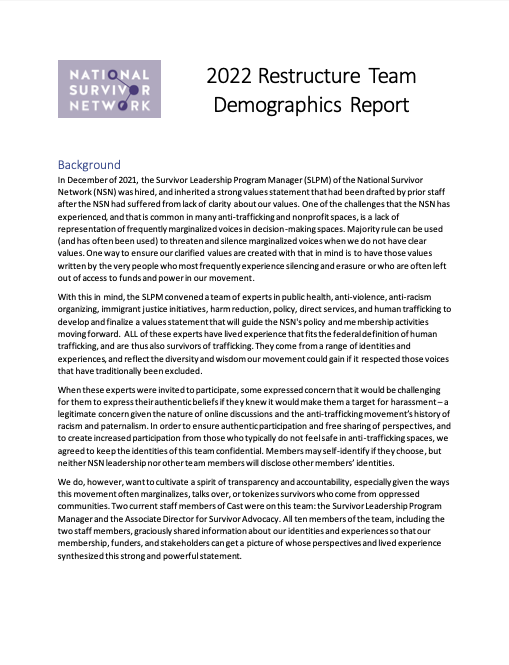In December of 2021, I started a new position in which one of my initial tasks was to clarify and finalize our values statement to better reflect our public health and human rights stance. The staff people running my program before me had taken our existing set of values and clarified them to include a focus on the most marginalized survivors. They did this to ensure that more privileged survivors (whether societal privilege or privilege and power within the movement) did not create a space that is unsafe for survivors who had already experienced judgment and erasure in the movement. This clarified values statement had not yet been released at the time the prior staff left their positions.
These two staff who drafted the values statement had many marginalized identities that I do not have, and I did not want to have sole responsibility for revising and finalizing the statement. I decided to convene a restructure team to meet regularly throughout January to revise and clarify the statement. This team would be well-compensated for their time, and it would be made clear to them that compensation was not dependent upon minimizing their perspectives or invalidating their own experiences. I began thinking of my dream team – who were the survivors who came to mind who had perspectives that have not typically been heard? Who are the survivor leaders who are well-placed but fearful to speak out about their actual values for fear or losing income or position? How could I bring them together for a real conversation about what we believe and want in the movement?
This was complicated by the fact that the need for a values statement came to a head in my organization in 2019 when a lack of shared values led to a crisis when survivor leaders (some with immense power in the movement) created campaigns of harassment and digital abuse against survivors who did not agree with them, leading many survivors to leave the movement or experience personal health impacts and the organization to pause its policy work. This was my first ethical dilemma: How can I invite survivors from some of the most marginalized communities in our society to join me in this process when I know they do so at great risk to themselves? How can I create a container of trust when at least two of the survivors I was considering work primarily in harm reduction fields that regularly experience violence from trafficking advocates and as a result of “anti-trafficking” policy?
I knew that as a white person with a full-time job at an organization that supports this values clarification process, I have privilege. I decided to offer confidentiality for all members of the restructure team, and ensured those I invited that I would not disclose their identities to the movement. I let them know they were each welcome to self-disclose that they were part of the process if they wanted, but that I would not disclose their identities, and that they were not to disclose other members’ identities. With this in place, nobody would become a target unless they chose to disclose for themselves.
However, transparency is a value I also hold, and I do feel accountable to the membership to be clear with them about who was on the team. Especially given my own identities, I did not want our membership to question whether the group was truly representative of our movement. Transparency is important to me, so my second ethical dilemma centered around how to balance safety for the team members with transparent accountability to the network’s current membership.
To resolve this, I drafted a basic demographic questionnaire. During one of our meetings, I presented the draft to the restructure team and invited them to collaboratively revise and build it out with me. I explained the purpose, and how it was part of an effort to balance confidentiality/ safety and transparency/ accountability. Together, we created the questions we felt would accurately represent the diversity of our lived experiences, and by our final meeting, each member had filled it out. I drafted a report and was able to share it with our membership as I explained the values clarification process.
Obviously, an ideal situation would be one in which survivors of trafficking could provide honest feedback and insights without fearing that their voices would be silenced, questioned, or attacked by other survivors or other movement leaders. Unfortunately, this is not our current reality, and I hope my attempt to balance safety with transparency provides a reasonable solution.
project manager, author

